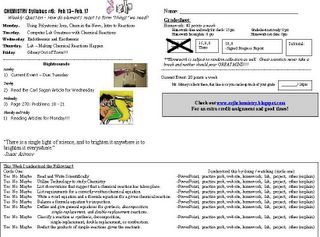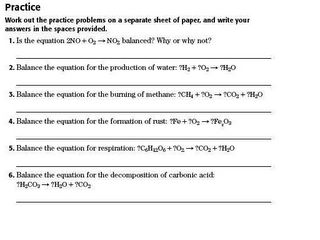Wednesday, February 22, 2006
1. A
2. C
3. D
4. A
5. D
6. B
7. B
8. B
9. C
10. D
11. B
12. D
13. D
14. D
15. B
16. A
17. D
18. C
19. A
20. C
21. B
22. C
23. C
24. A
25. A
26. C
27. A
28. D
29. D
30. C
31. D
32. A
33. C
SHORT ANSWER
34. The enthalpy change for a reaction equals the total enthalpy of the products minus the total enthalpy of the reactants. Just Delta H
Monday, February 13, 2006
Resources for Chem Bonding
Sunday, February 12, 2006
Saturday, February 11, 2006
Wednesday, February 08, 2006
Study Guide Chem Periodic and Naming Answers: Week 5
1. A
2. C
3. D
4. D
5. B
6. D
7. C
8. D
9. A
10. C
11. C
12. D
13. A
14. A
15. C
16. D
17. A
18. C
19. D
20. D
21. B
22. D
23. D
24. C
25. C
26. B
27. C
28. B
29. B
30. D
31. B
32. C
33. C
34. C
35. A
36. B
37. B
38. D
39. B
PROBLEM
40. 83.98 g/mol AlF3
26.98 g/mol Al + (3 ´ 19.00 g/mol F) = 89.3 g/mol AlF3
41. 101.96 g/mol Al2O3
(2 ´ 26.98 g/mol Al) + (3 ´ 16.00 g/mol O) = 101.96 g/mol Al2O3
Wednesday, February 01, 2006
Chem Periodic Table, Bohr Models, Nuclear Reactions - Study Guide Answers
MULTIPLE CHOICE
1. A
2. C
3. B
4. A
5. B
6. A
7. C
8. B
9. C
10. D
11. B
12. C
13. C
14. A
15. C
16. A
17. A
18. C
19. B
20. C
21. D
22. D
23. B
24. D
25. C
26. A
27. A
28. A
29. A
30. D
31. C
32. A
33. A
34. B
35. A
36. A
37. A
38. C
39. C
40. B
41. A
42. C
43. D
44. B
45. C
46. A
47. A
48. A
49. D
SHORT ANSWER
50. Their locations in the periodic table indicate that phosphorus and sulfur are nonmetals and sodium is a metal. Nonmetals are a group with characteristic properties, so phosphorus and sulfur are the most similar elements of the three.
51. In the periodic table, elements in the same column or group have similar properties. Because helium and xenon are in the same group, they have similar properties.
52. Their outer energy levels are full.
53. The mass of a proton and a neutron are about the same, and the electron is about 1,836 times smaller.
54. There are only 26 capital letters and more than 100 elements, so the lowercase letters are needed to help tell elements apart.
55. F, fluorine, 9, 18.998; O, oxygen, 8, 15.999; P, phosphorus, 15, 30.974; S, sulfur, 16, 32.066
56. F, period 2, Group 17; O, period 2, Group 16; P, period 3, Group 15; S, period 3, Group 16
57. Na, sodium, metal; Ba, barium, metal; Ca, calcium, metal; La, lanthanum, metal; Ti, titanium, metal; Al, aluminum, metal; As, arsenic, metalloid; At, astatine, metalloid; Ar, argon, nonmetal
58. same group
59. metals
60. similar
61. solids
62. A controlled-fission chain reaction releases energy in a nuclear reactor. The energy is used to produce steam, which is used to drive the generators that produce the electricity.
63. Fusion reactions are difficult to control because no known material can withstand the initial temperatures required (about 108 K). Some solutions being investigated are containing fusion reactions within a magnetic field or inducing fusion at lower temperatures.



